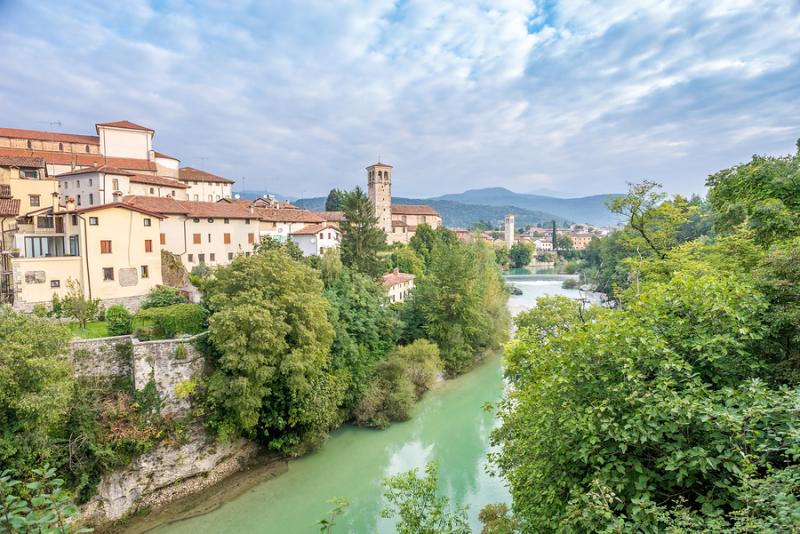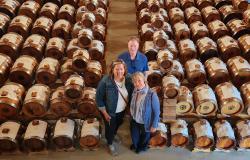Set right on the slopes of the Eastern Hills of Friuli, on a picturesque ravine over the river Natisone, Cividale del Friuli is a cozy village still bearing many witnesses of its glorious past. Its historical center has been enlisted among the UNESCO World Heritage Sites in 2011, and the town was the leading proponent of the project mapping the Italian Lombard's power locations throughout the whole country.

The Lombard – or Longobard – remaining are probably the most important historic and architectural legacy that Cividale still bears from its past. The origins of the town, though, are much older: taking its name by forum julii – where the Friuli region's name itself comes from – it was founded in 53 BC by Julius Caesar, the Roman emperor.
The Lombard king Alboino later chose it as the capital of the first Lombard duchy in the region, which eventually became one of the most influential when it was chosen as his seat by Callisto, the mighty patriarch of Aquileia. When the Lombard kingdom was defeated by Charles the Great, it became Regnum Italia and Cividale was part of it; later on it was under the Venetian domain and finally annexed to the Italian Kingdom in 1866, which became a Republic in 1946. After Second World War, Cividale was among the places awarded for their military bravery.
A walk through the town will easily let you get all this almost at a glance: beautiful ancient buildings face over pretty squares and small streets and the Santa Maria Assunta cathedral – dating back to the XV century even though the interior was renovated in the XVIII century mainly using local wood and stone – is a notable example of the Venetian Gothic style mixed to Renaissance. The cathedral is well worth a visit to admire the gold-decorated altarpiece and the evocative crucifix statue made of lime wood.
But what you really should not miss is the annexed Christian Museum of the Cathedral with its two sections: the Lombard heritage features outstanding examples of Lombard art such as the Ratchis Altar, commissioned by Duke Ratchis, later King of Lombard Italy, to commemorate his father Pemmone; the altar was originally finely decorated in a stunning polychromy, that visitors can retrace thanks to a special multimedia layout projecting the reconstruction of the decoration over the piece. This section also shields the above mentioned Callisto Baptistery, an octagonal structure with columns and arches which was commissioned by the first Patriarch of Aquileia. The Treasure of the Cathedral, on the other hand, displays many interesting jewelery and liturgical objects, paintings and manuscripts representing the long and rich Christian history of Cividale.
Proceeding towards the historic center, in Corso Giuseppe Mazzini, shortly stop by the Farmacia Fornasaro: the modern chemist's shop hides an interesting collection of medical tools and bizarre objects: several apothecary vases, a medieval doctor's bag, a lady's cuspidor, a signed prescription dating back to 1812 and so on.
Further on, the charming piazza Paolo Diacono, named after the Lombard monk and historian who wrote the Lombards' history, is better known as “the women square”. Here, local women used to sell their goods at the market, including the delicious cherries growing in the surrounding Collio area. Facing over the fountain topped by a statue of Diana, goddess of the hunt, there is a beautifully fresco-decorated building dating back to the XV century: a plaque indicates that here stood the house where was (probably) born Paolo Diacono.
 piazza diacono
piazza diacono
Flanking the ancient stonewalls, you will enter the oldest part of the town, where once stood the jewish ghetto: walking through the narrow stone-paved streets you will bump into picturesque medieval houses, old workshops – the blacksmith's one, closed down in the 70s, is now a sort of small museum that you will be able to visit if lucky enough to find it open – and the beguiling Celtic hypogeum made of several underground rooms carved out of the rock, probably used by Celts (among the first to inhabit the place) as a burial place or by Lombards as a jail. Every August, this part of the city hosts the evocative Palio di San Donato, a medieval pageant when the town finds back the atmosphere of long-gone times.

Further on, you will finally get to the unique Lombard Temple, an extraordinary example of Early Mediaeval architecture. Its origin is still mysterious: currently named Oratory of Santa Maria in Valle – as it became part of a Benedictine cloistered convent until the 90s, while today it's being transformed into a Museum – probably it was originally built in VIII Century as the palace's chapel of the Gastaldaga, the residence of the King's gastald, as they were named the officials in charge of the local governments under the Lombard Kingdom.

The squared room has cross-like vaults and a presbytery with the three barrel naves. Walls and ceilings are finely garnished by frescos and stucco decorations with distinctive Byzantine features; the apse was once adorned by a mosaic, now lost, while the archivolt still bears an elegant decoration with vines and grapes dominated by six women statues.
From the temple, you can access to another chapel with a wooden choir, or to the outer belvedere: a small yet stunning viewpoint overlooking the Natisone river and the impressive gorge where the Devil's Bridge stands. Daringly built in the XV century – and rebuilt in 1918 after being destroyed by bombings - with two asymmetrical arches resting on a boulder in the middle of the riverbed, the bridge is more than 20 meters-high. According to the legend, the inhabitants asked the Devil's help to build it, in exchange for one of their souls; they were clever enough, though, to make a fool out of him giving a dog's soul instead.

Before going back to the Women's Square to enjoy an aperitivo at the recently renewed Caffé Longobardo, stop by to cherish the colorfully frescoed facade of the small church of Santi Pietro e Biagio, in the tiny square of San Biagio.






